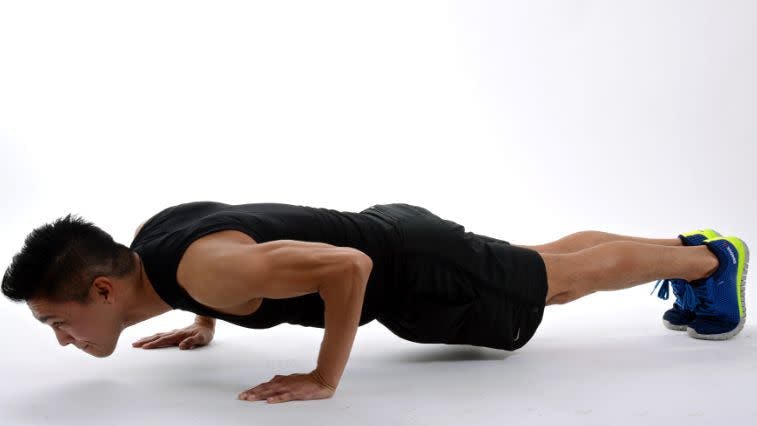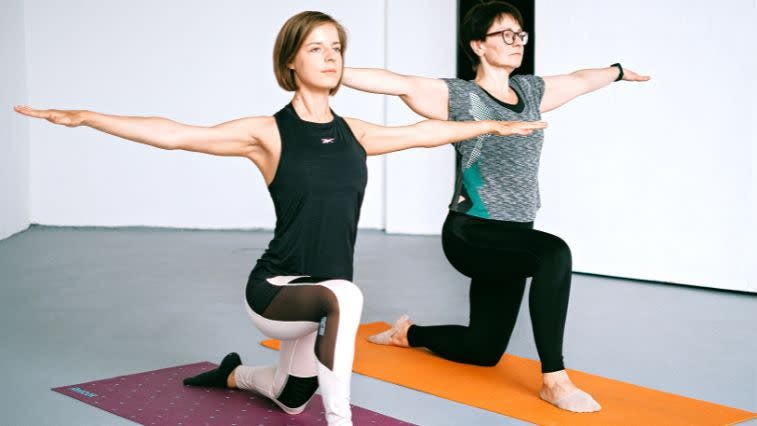The Ultimate Beginner’s Guide to Building Muscle at Home (No Equipment Needed)
Our content strives to support, inform, and motivate you to meet your health goals. We want to be your trusted source of expert- and science-backed info dispensed in simple, actionable ways. Read our Editorial Guidelines.
Not everyone likes the gym… gasp! I’m Coach D, a certified personal trainer, and many of my beginner clients say the gym can be overwhelming and intimidating. Others who prefer working out at home may do it for the flexibility, accessibility, or they just prefer to touch their own sweat and use their own equipment.
Regardless of the reasons you may not go to the gym, you don’t need a gym to get a great, effective workout. Exercising at home can be just as effective, with or without equipment.
When starting a new exercise program, consider the following before your first workout:
age
fitness goals
how often you can train
any physical restrictions you may have
at-home equipment: what do you have and what will you need
a workout plan that takes all of the above into consideration, provides structure, and is designed to help you get the results you want
Bodyweight training is a great foundation for beginners looking to start a training program. Although it takes longer to build muscle mass using your own body weight, it does help you increase strength, endurance, power, and stability. In this article, we’ll explore the best ways to build muscle at home without equipment. For my intermediate and advanced enthusiasts, this info can refresh your knowledge and even add to your current program.
Bodyweight Training Is Strength Training
Strength training, also known as resistance training, is a type of exercise where muscles contract against an outside resistance. This resistance can be your body weight, weighted machines, free weights, or resistance bands.
There are two types of strength. Absolute strength is the ability to move any given load, regardless of body size. An example would be performing squats while holding a barbell with 200-pound weights. Relative strength is the ability of a person to control and move their body through space.
Many people can get caught up in lifting as much weight as possible (absolute strength), but can overlook the importance of moving weight that’s relative to their body weight (relative strength).
Having high relative strength has its advantages. It allows your body to generate more power and be more explosive in your movements. Athletes (gymnasts) and exercisers with greater relative strength tend to perform and move better in sports and workouts. Even non-athletes can benefit from relative strength; for example, it allows elderly people to walk independently or get up from a chair without help.
Benefits of Bodyweight Training
One of the biggest benefits of bodyweight training is accessibility. In the summer of 2018, a trainer friend of mine (Emma Bonoli) and I created an outdoor workout class for women in the Bronx next to Yankee Stadium. These park workouts were bodyweight only. We had access to a track, stairs, bars, and a stereo (music is important). We saw the following benefits for our clients.
Increased Cardio Endurance
When we started, most of the women were winded by just walking. We built the ladies’ cardiovascular fitness by doing dynamic warm-ups and exercises like 50-yard sprints, stair sprints or hill sprints. After training this way twice a week for a few weeks, we saw boosts in cardio ability.
To increase your heart rate at home try these exercises:
Increased Muscular Endurance

As trainers, Emma and I felt it was important for each woman to have a good foundation in their movements. We first taught how to squat, hinge lunge, push, and pull. Having a good foundation of bodyweight exercises will lead to proper form if you progress your regimen with weights.
In the park, we had access to monkey bars and TRX suspension straps. Working in a rep range of 15–20 reps, we performed exercises like:
TRX push-ups, ground push-ups
Increased Overall Stability
Suspension training still uses your body as resistance against gravity. It’s a way to build core stability, balance, and flexibility simultaneously. The TRX is a tool that can be modified for beginners. As you increase your overall strength, TRX exercises can be progressed.
Strategies for Building Muscle With Bodyweight Exercises
According to the International Sports Science Association (ISSA), bodyweight strength training can increase strength and muscle mass. As a beginner, your body will adapt quickly to the resistance placed on it. The amount of time it takes to gain muscle mass varies from person to person. In a periodized program (a training plan that includes different phases and cycles), it could take 8–12 weeks.
There are few studies that examine the amount of muscle mass produced with bodyweight exercises. You could see a plateau in muscle gains early on in a bodyweight program. Don’t worry, there are ways to manipulate muscle-building processes in bodyweight training, such as:
Increase reps: To build strength, you typically work in a 2- to 6-rep range. To build muscle, you work in a 6 to 12 or higher rep range.
Decrease rest time: Rest in between your sets is important. If you typically take a 60- to 90-second rest between sets, make 60 seconds your maximum rest time. If you notice that you need less rest after a set, then you know you’re improving.
Increase time under tension: Muscle growth happens when muscles are placed under tension. You can do this by slowing down your movements or adding a tempo. An example would be a tempo push-up. To make it tempo, add a count to the push-up, such as 3-1-3. Count to three and don’t get to the bottom of the push-up until you’re on 3. The next number, 1, is the amount of time you stay low to the ground. The last number is the amount of time it takes you to get to the top of the movement.
Work your muscles to fatigue: Working your muscles to fatigue can be done by following a Tabata (20-second intense intervals followed by 10 or 15 seconds rest) or AMRAP (as many reps of possible) routine. This means that you will perform as many reps as you can with correct form with minimum rest. I suggest you only do this once a week for your cardio day.
Programming Your Bodyweight Training Sessions
Now that you have more knowledge about bodyweight training, let’s develop an exercise program. Common types of bodyweight training includes calisthenics (push-ups, pull-ups, crunches) and plyometric training (jumps, skips, power exercises).
When programming your bodyweight training workouts, start with the seven major movement patterns:
Bodyweight Exercises

Knee-dominant | |
Hip-dominant |
|
Vertical push | Tricep dips |
Vertical pull | |
Horizontal push | Push-ups |
Horizontal pull | Inverted rows |
Core |
Train for strength as a beginner 1–2 days, intermediate 2–3 days, and advanced 3–4 days a week. Workouts should be split between 30–60 minutes. Perform 2–6 sets of 6–12 reps of each exercise. At the beginning of your workout, always plan an active dynamic warm-up.
Here’s a sample of what a weekly split can look like:
Weekly Split Sample
Monday | Full body |
Tuesday | Lower/upper body push + core |
Wednesday | Rest |
Thursday | Lower/upper body pull + core |
Friday | Full body |
Saturday | Rest/active rest* |
Sunday | Cardio/active rest |
*Active rest means that you stay active and do gentle movements like easy cycling, walking or hiking, yoga, or Pilates.
Full Body Workout Sample
When programming a full body workout, include the seven movement patterns.
Squats are a great start. You can adjust your squat pattern to any fitness level.
Single-leg squats (good for all levels)
Pistol squats (intermediate or advanced move)
Sumo squats (good for all levels)
Pulse squats (good for all levels)
For this full-body workout, complete 4 sets of 12 reps of all exercises unless otherwise noted. Start with:
Prisoner squats 3-0-3 (tempo down 3, pause, up 3)
I always try to balance a push with a pull. Here you can do a vertical pull with a horizontal push. Use any variation of the following to match your fitness level:
3. Pull-ups
4. Push-ups
Then you can break up upper body with core:
5. Side planks: hold 30 seconds each side
Finish with a vertical push and horizontal pull
6. Tricep dips
7. Inverted rows
Lower & Upper Body Push Sample
Complete 4 sets of 12 reps of each of the following:
Glute bridges
It's About a Good Foundation
Bodyweight training is a great way to create a fitness foundation when you’re a beginner. It’s also a great way for intermediate and even advanced exercisers to increase range of motion and learn how to complete new or more complicated exercises with good form. Bodyweight exercises give you variations to support flexibility, agility, balance, strength, and explosiveness.
If you need resources on how to move correctly, check out the Kickoff app. Sign up for a free consultation with a certified personal trainer who can help you establish a workout routine that’s bodyweight or uses weights.